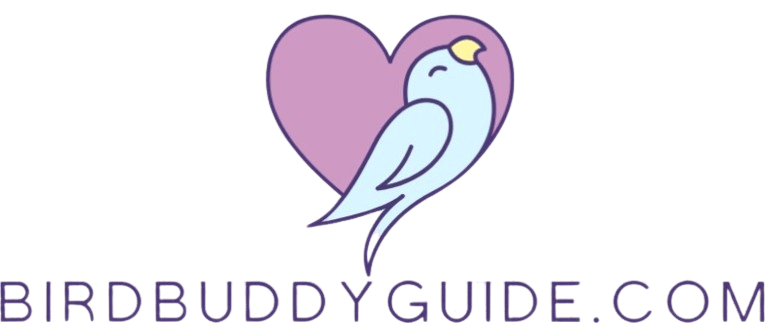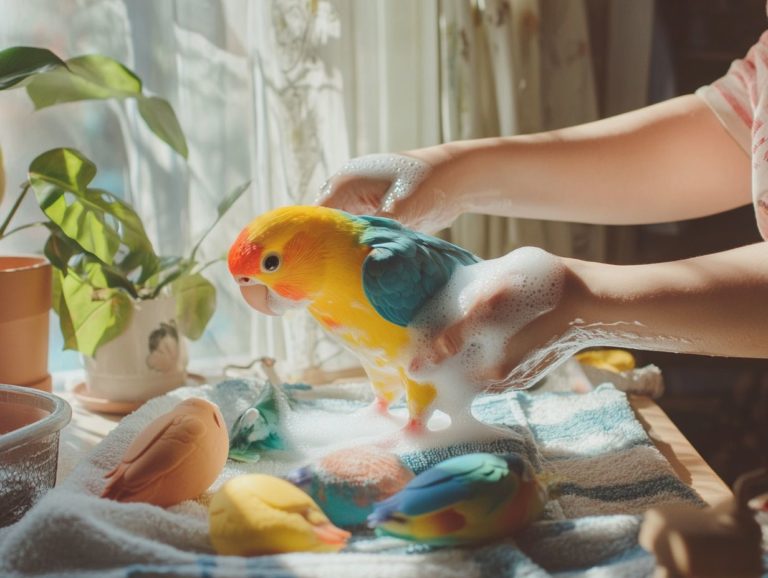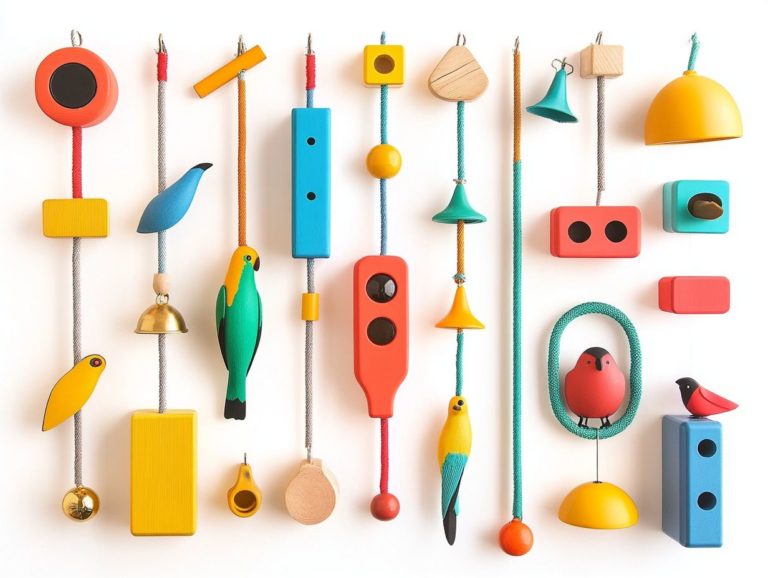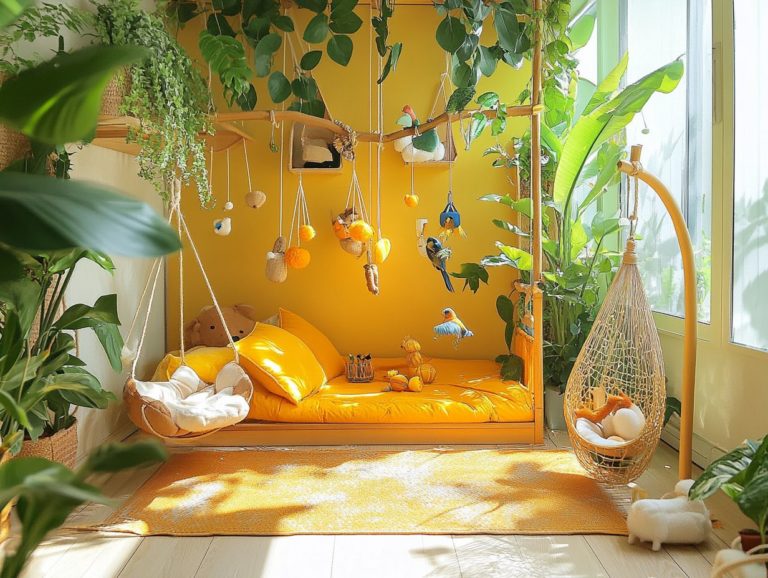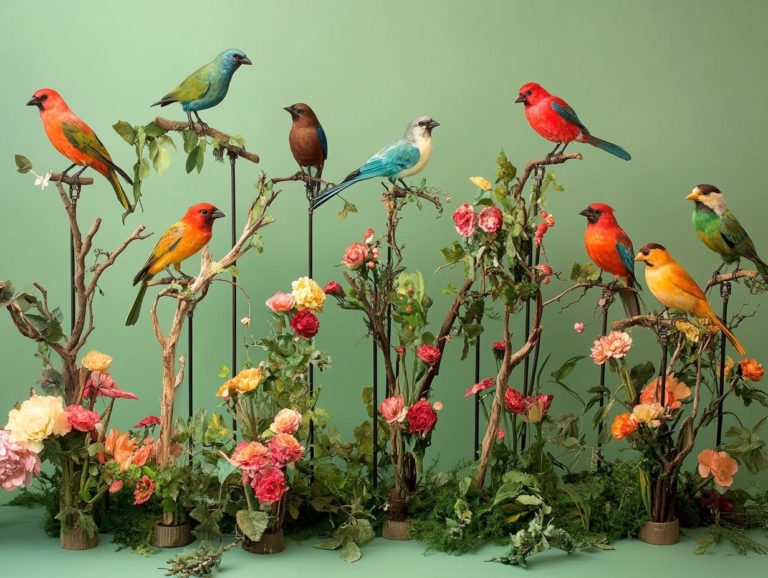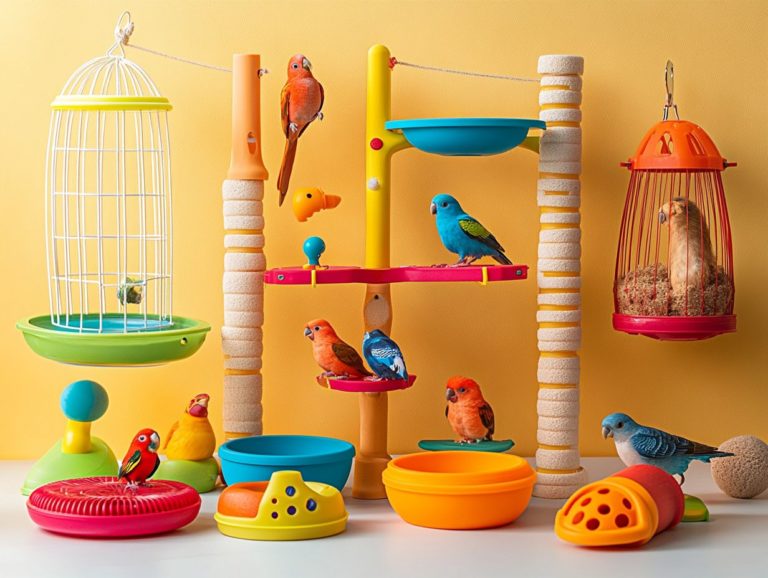How to Evaluate Bird Toy Hygiene
Keeping your feathered friends healthy and happy involves more than just providing food and shelter; it extends to their toys as well.
Hygiene is key to ensuring that bird toys remain safe and free from harmful contaminants. This article delves into the potential health risks associated with unhygienic toys, helps you identify signs of contamination, and provides a step-by-step guide for effectively cleaning and disinfecting them.
You ll also discover the best materials for bird toys, how often they should be cleaned, and tips for proper storage. By the end, you ll have all the knowledge needed to create a clean and safe play environment for your birds.
Contents
- Key Takeaways:
- Why Hygiene is Important for Bird Toys
- Signs of Unhygienic Bird Toys
- Cleaning and Disinfecting Bird Toys
- Choosing Safe Materials for Bird Toys
- Frequency of Cleaning Bird Toys
- Proper Storage of Bird Toys
- Frequently Asked Questions
- What are the key factors to consider when evaluating bird toy hygiene?
- What materials are considered safe for bird toys?
- How often should bird toys be cleaned?
- What is the best way to clean bird toys?
- Are there any signs that a bird toy needs to be replaced instead of just cleaned?
- Why is it important to regularly evaluate bird toy hygiene?
Key Takeaways:
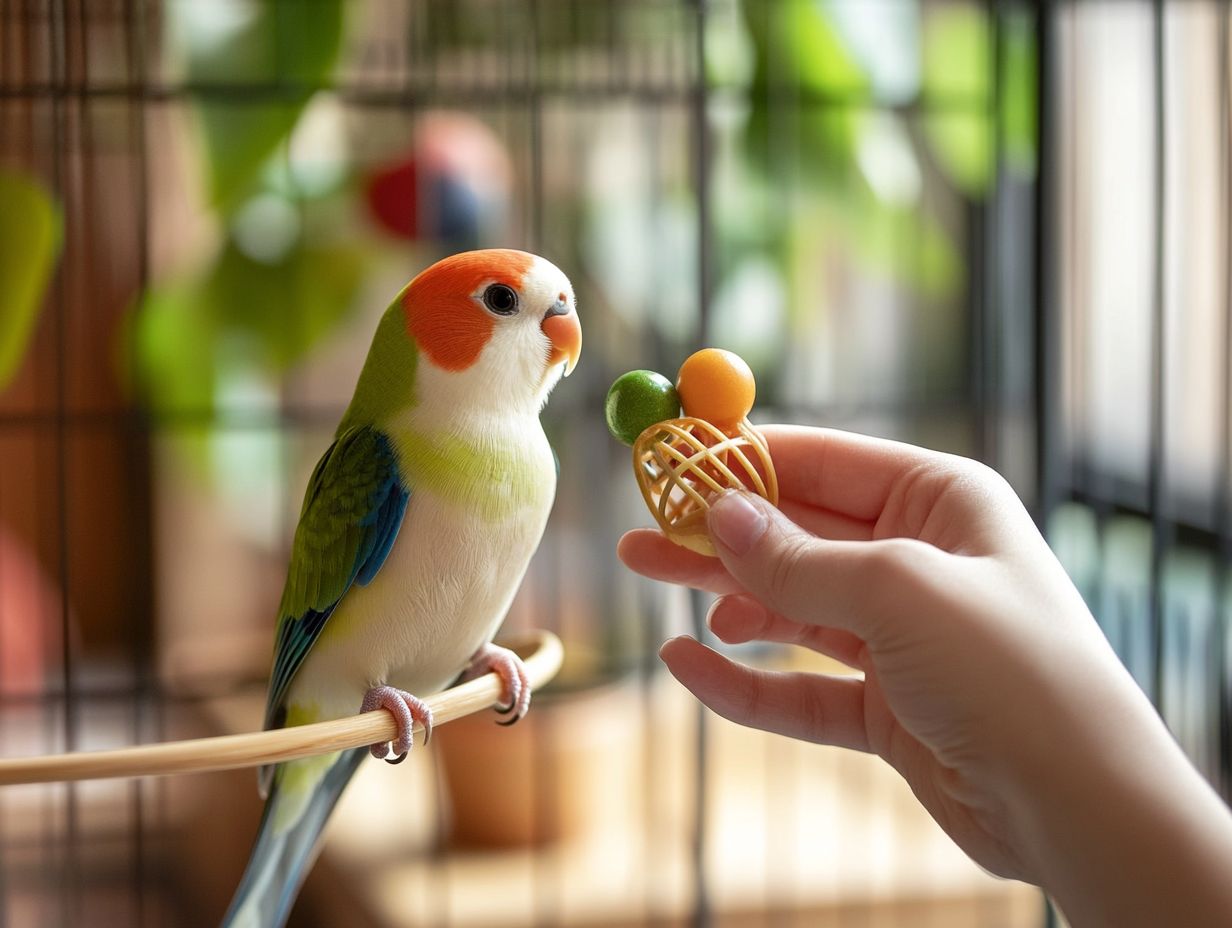
- Regularly clean and disinfect bird toys to prevent potential health risks and keep your feathered friend safe and healthy.
- Signs of unhygienic bird toys include visible dirt, mold, and strong odors. Identify potential contamination to ensure your bird stays healthy.
- Choose safe materials for bird toys, such as stainless steel and untreated wood, to make cleaning and disinfecting easier and more effective.
Why Hygiene is Important for Bird Toys
Keeping toys clean is key to your bird’s happiness and health! The materials used in bird toys, whether crafted from safe woods or other less suitable options, can greatly influence your bird’s mental stimulation and physical health.
By maintaining proper toy hygiene, you can prevent contaminants from accumulating and posing health risks to your feathered companions. Clean toys play an important role in keeping birds mentally stimulated and engaging in safe activities that contribute to their happiness and overall health.
Potential Health Risks
Using bird toys made from unsafe materials can expose your pet birds to a range of health risks. Toxic substances may lead to serious health issues.
For instance, toys made from untreated wood might harbor harmful chemicals or pesticides that could negatively impact your bird’s respiratory system. Plastic toys can leach harmful chemicals, like phthalates, which disrupt bodily functions.
Cheap toys often feature metal components that may be coated with lead or zinc substances that can cause neurological damage if ingested. Scrutinize the materials used in your pet’s toys and prioritize options that guarantee both safety and durability.
Signs of Unhygienic Bird Toys
Identifying signs of unhygienic bird toys is crucial for safeguarding the health and well-being of your pet birds. Contaminated toys can pose significant risks, resulting in illness or distress among your feathered companions.
Look out for common indicators of unhygienic toys, such as visible dirt, mold, or unpleasant odors these are clear signals that proper cleaning has been neglected. Toys displaying signs of wear and tear are also more prone to harbor harmful bacteria or toxins.
Your vigilance in monitoring these details ensures a safe and healthy play environment for your birds!
Identifying Contamination
Identifying contamination in bird toys requires your keen eye and attention to detail. Focus on various factors like appearance and smell.
As a bird owner, remain vigilant for signs such as discoloration or unusual stains, which could indicate mold or chemical residue. A foul odor often signals bacterial growth or other harmful substances. The presence of pests like mites or insects is a clear red flag that demands immediate action.
Make regular cleaning a top priority your bird s health depends on it! Opt for bird-safe cleaning solutions and ensure that the toys are thoroughly dried. Consistent inspections can help you catch potential problems before they escalate into serious concerns.
Cleaning and Disinfecting Bird Toys
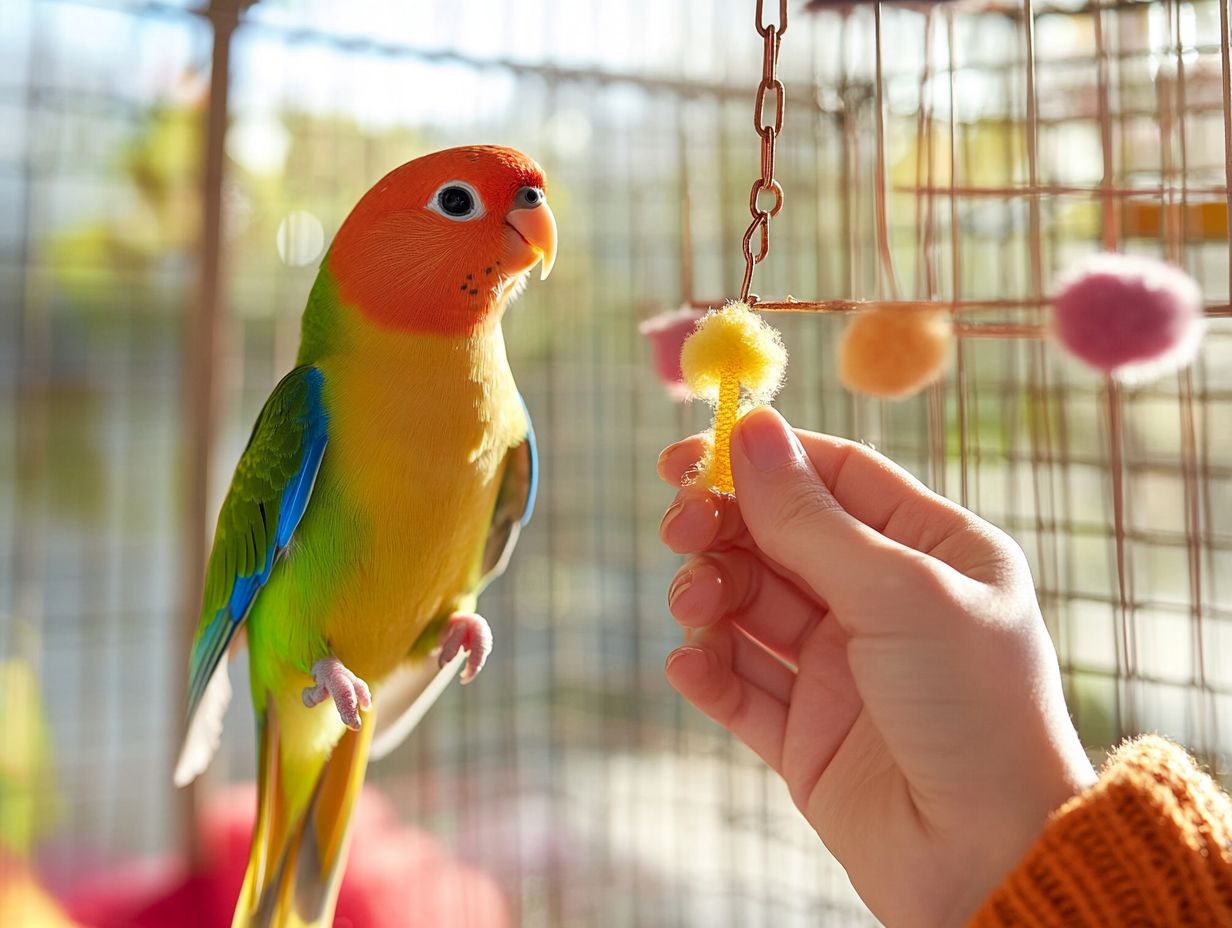
Cleaning and disinfecting bird toys is vital for safeguarding your pet birds’ health and well-being. By following a clear method, you can effectively eliminate dirt and potential contaminants that could harm your feathered friends.
Begin by inspecting the toys for any visible wear or damage. Separate those made from different materials like acrylic and wood to avoid cross-contamination during washing. Use safe cleaning agents to scrub the toys meticulously, paying particular attention to the crevices where bacteria might hide.
Step-by-Step Guide
A step-by-step guide to cleaning bird toys is essential for effective disinfection and maintenance. By following these clear steps, you not only prolong the toys lifespan but also contribute to your birds’ overall health and happiness.
- Start by categorizing the toys based on their materials, as wood and acrylic require different cleaning approaches.
- For wooden toys, a mixture of vinegar and water effectively eliminates bacteria while remaining safe for your feathered companions.
- Acrylic toys can be scrubbed with mild soap and thoroughly rinsed to remove any residue.
- After cleaning, allow the toys to dry completely in a well-ventilated space to prevent mold from forming.
- Lastly, store the toys in a dry, clean environment to keep them safe, ensuring playtime remains enjoyable and secure.
Choosing Safe Materials for Bird Toys
Selecting safe materials for bird toys is crucial for your pet birds’ health and safety. By choosing appropriate materials like pine, balsa, or birch, you can minimize their exposure to harmful substances and enhance their playtime.
Unsafe materials can pose serious health risks to your birds. Understanding which materials are safe and which are not is vital for optimizing toy safety and creating a stimulating environment.
Best and Worst Materials for Hygiene
Understanding the best and worst materials for hygiene in bird toys is critical for promoting your pet birds’ health. Choosing the right materials significantly impacts their overall well-being.
Materials like stainless steel and certain non-toxic plastics (safe for birds and free of harmful chemicals) excel in hygiene; they’re easy to clean and resist harmful bacteria.
On the other hand, natural woods can harbor parasites if not treated properly, while poorly manufactured synthetic materials may contain toxic substances, putting your birds at risk. By recognizing these choices, you can create a healthy play environment that protects your birds from infections and fosters safe, enjoyable interactions through thoughtfully designed toys.
Choosing the right materials will make a huge difference in your birds’ happiness!
Frequency of Cleaning Bird Toys
Establishing a regular cleaning schedule for your bird toys is essential for a hygienic environment. Implementing a routine ensures that the toys remain free from contaminants, contributing to your birds’ health and well-being.
Depending on how often your birds play and the materials involved, aim to clean the toys weekly or bi-weekly. Pay extra attention to particularly dirty toys or any that have come into contact with food or droppings.
Don t wait! Clean your bird toys weekly to keep your pets safe and healthy. Consistent cleaning not only keeps the toys fresh but also helps prevent the accumulation of harmful bacteria and toxins, ensuring a safe space for your beloved pets.
Recommended Cleaning Schedule
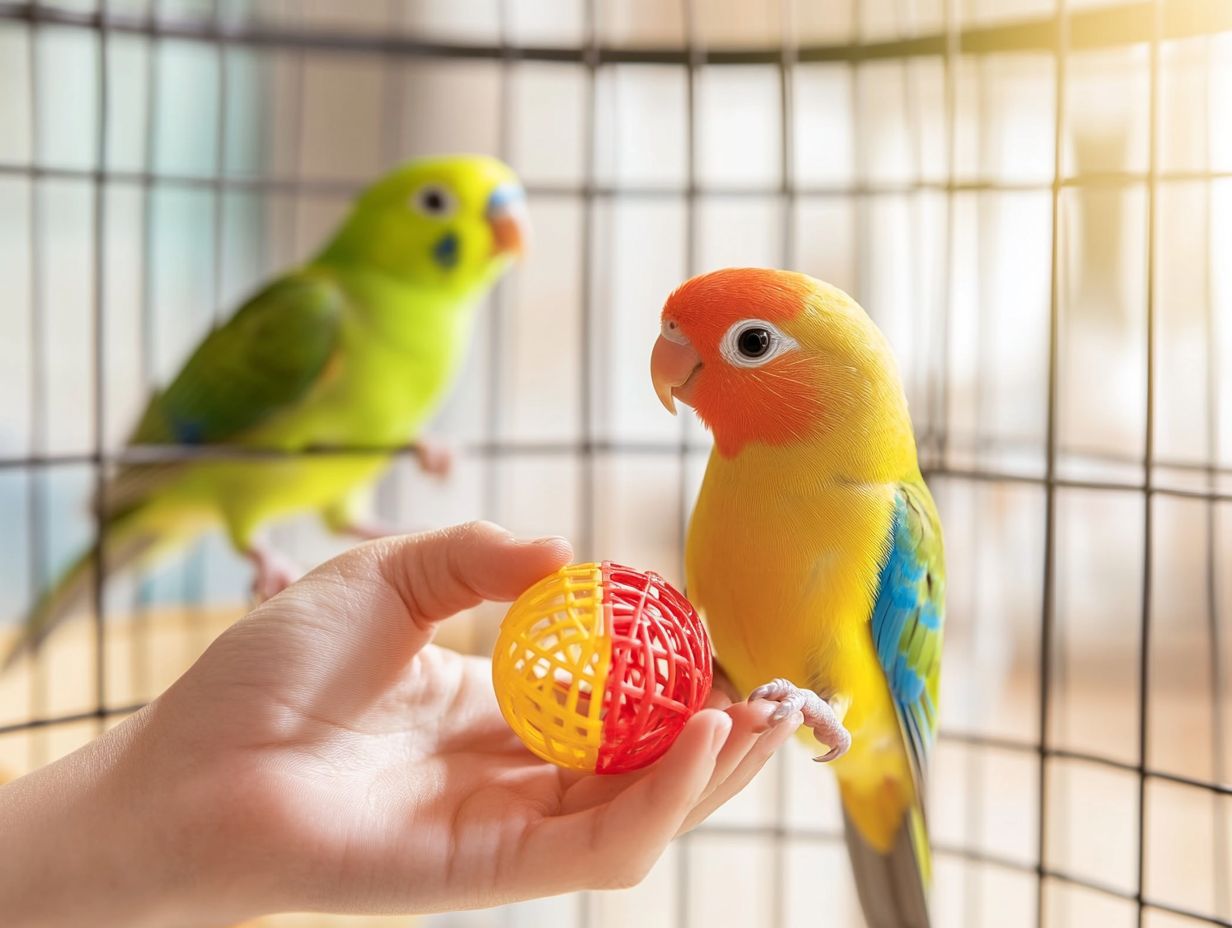
Establishing a recommended cleaning schedule for bird toys can significantly enhance their hygiene and safety. Creating this routine will make your birds thrive!
Generally, wooden toys should be cleaned weekly as they can harbor bacteria. Plastic toys might require attention every two weeks, depending on how much your bird uses them.
Rope toys may need more frequent inspections due to potential fraying and debris accumulation. Staying alert helps you decide how often to clean by checking for signs of wear and tear, such as discoloration or visible damage.
By following this approach, you contribute to a healthier and more stimulating habitat for your birds.
Proper Storage of Bird Toys
Properly storing bird toys is crucial for ensuring they remain clean and safe for your pet birds. Employ effective storage solutions think dedicated bins or shelves to shield these toys from dust, moisture, and pests that could jeopardize their hygiene.
Organizing the toys by type, such as foraging and chewing toys, makes it easy to access them. This promotes regular playtime and provides your feathered friends with the mental stimulation and cognitive enrichment they thrive on.
Tips for Keeping Toys Clean and Safe
Implementing effective strategies for keeping your bird toys clean and safe can significantly enhance your pet birds’ health and happiness.
Incorporate regular inspections into your routine to easily spot wear and tear that may pose safety risks. Make sure to use bird-safe cleaning solutions to keep your feathered friends happy and healthy think mild dish soap and vinegar tailored for materials like wood, plastic, and cotton.
When cleaning, rinse thoroughly with water to eliminate any residues, as birds have particularly sensitive respiratory systems.
Storing the toys in a dry, well-ventilated area is essential to prevent mold growth. Opt for a designated container made of non-toxic materials to keep the toys organized and free from contaminants.
Frequently Asked Questions
What are the key factors to consider when evaluating bird toy hygiene?
The main factors to consider are the materials used in the toy, how easy it is to clean, and how often it needs to be cleaned.
What materials are considered safe for bird toys?

Bird-safe materials include untreated wood, natural fibers, and stainless steel. Avoid materials that could be harmful if ingested, such as plastic or treated wood.
How often should bird toys be cleaned?
Bird toys should be cleaned at least once a week. However, toys that are heavily used or contain food should be cleaned more frequently, ideally every other day.
What is the best way to clean bird toys?
The best way to clean bird toys is by soaking them in a mixture of hot water and a pet-safe disinfectant. Scrub them with a brush and rinse thoroughly before drying.
Are there any signs that a bird toy needs to be replaced instead of just cleaned?
Yes, some signs that a bird toy needs to be replaced include broken or splintered pieces, frayed ropes or strings, and excessive wear and tear that could potentially harm the bird.
Why is it important to regularly evaluate bird toy hygiene?
Birds can be very sensitive to bacteria and germs, so regularly evaluating and maintaining the hygiene of their toys is crucial for their health and well-being. For more information on this topic, refer to understanding bird toy materials and safety. Dirty toys can also lead to unpleasant odors and attract pests.
Assess your bird toys now for better hygiene and safety!
